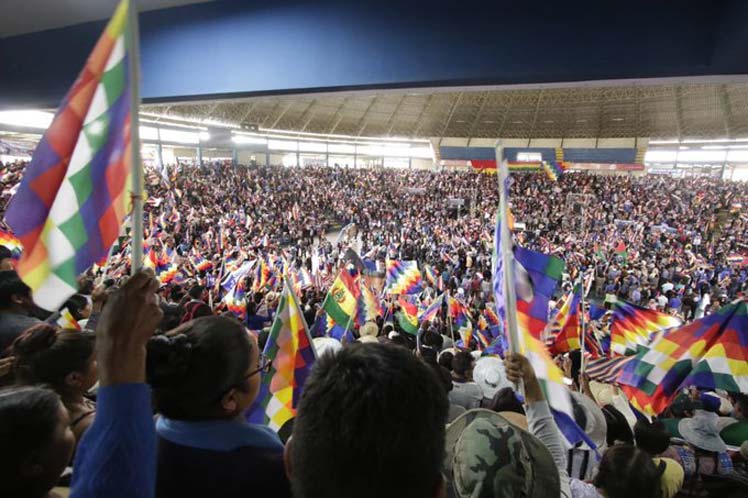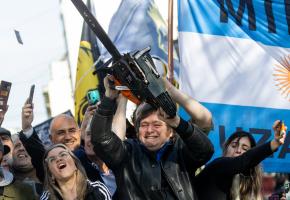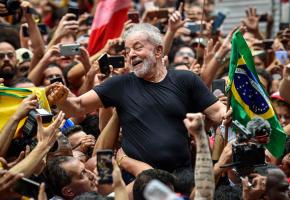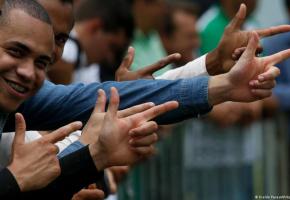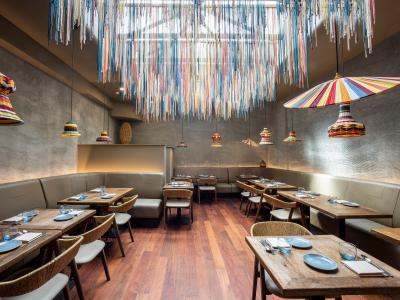Three months have passed since Bolivia’s disastrous October 2019 presidential elections. During this time, Evo Morales resigned from the presidency, sought asylum in Mexico, and arrived in Argentina on 12 December, two days after Alberto Fernández assumed the presidency there. Argentina has granted him refugee status. In Bolivia, an interim government has been formed, both chambers of congress passed legislation to annul the October elections and law makers have agreed to appoint a new electoral board that will be tasked with setting a date for a general election. Bolivia can finally see some light at the end of the tunnel after 21 days of anti-government protests which paralysed the country, followed by a two-day power vacuum after Morales and his immediate constitutional successors resigned. However this political crisis is far from over.
What surprised both many Bolivians and most outside observers was the extraordinary speed with which the Morales government collapsed or was removed, given that it appeared to be fully in control of most of the instruments of government and to enjoy the support of a majority of the population (albeit a majority whose size was disputed). This raises a number of crucial questions:
Why did the police suddenly turn against Morales?
Throughout his presidency, Evo Morales enjoyed years of immense popularity with all sectors of society, including the middle and upper classes. However, over the past few years this support diminished drastically, following a series of corruption scandals, numerous clashes with indigenous groups over government decisions to build a highway through Indigenous Territory and National Park Isoboro-Sécure and, most recently, the slow response to wildfires in the Bolivian Amazon, which destroyed over 5 million hectares of forest, and were at least in part the consequence of changes in government land policy.
Yet, no one envisioned that the October elections would prove to be the tipping point that was to end Morales’ government. Until then, it was believed that the opposition to Morales was almost exclusively made up of middle and upper class voters, who contested the legality of his candidacy after he lost the 21 February 2016 referendum, on what became known as ‘the re-re-election’. However this year, as people took to the streets to protest against an apparently rigged and fraudulent election, it became clear that discontent with the government had been simmering among all sectors of society.
In the 20 days after the presidential election, a paralysed Bolivia saw 2 million people, across the nine regions of the country, take to the streets to protest against the electoral fraud. Bolivia was stunned when students from the Public University of El Alto (UPEA), who had traditionally supported Morales, joined the anti-government protests and when they saw Damian Condori, member of the Ponchos Rojos, a radical indigenous group from North of La Paz, and president of the Unified Syndical Confederation of Rural Workers of Bolivia (CSUTCB), meet with other opposition leaders.
Cooperative miners from Potosi, who supported the Morales movement and government during the past 15 years, despite occasional differences, turned their back on their president and were received joyously by anti-government protesters in La Paz. To add to Morales’ misfortune coca growers from North La Paz who had grievances with the government joined the protests against a man whose political career started and ended as leader of the Coca Unions in Chapare.
It was difficult for Bolivia to imagine Morales ever being forced to step down because, throughout his presidency, the Armed Forces and the Police had remained fiercely loyal. However, in more recent years the Bolivian police began to nourish a sense of resentment towards Morales, as they felt that, in contrast to the military, they were being neglected by the administration. Between 2017 and 2018, military expenditure in Bolivia increased from US$455.91 $US million to US$598 million.
Thus, it is not surprising that after two weeks, as anti-government protesters pleaded with the police to join them, they did so, after assurances from civic movement leader Luis Fernando Camacho, who appointed himself as the leader of the anti-Morales movements, that future governments would ensure that police salaries and benefits would equal those of the Armed Forces. On the 25 November, the General Commander of the Police, sent a letter to the interim government requesting this salary levelling.
Camacho was the president of the Santa Cruz Civic Committee, the stronghold of Bolivia’s right wing. Despite repeatedly claiming, during the protests, that he had no political agenda or interest, the radical right-wing civic leader has lost credibility by announcing his candidacy in the next presidential election.
Why did the Army side with the police?
Military expenditure throughout the Morales government had been roundly criticised and called blatant bribery by the press and opposition parties, who regarded it as unnecessary expenditure. Thus, anti-government protesters as well as Morales were taken by surprise, when Williams Kaliman, then Commander-In-Chief of the Armed Forces of Bolivia, a self-proclaimed ‘soldier of the process of change’ and ‘anti-colonialist’, sent a formal letter suggesting that Morales should resign.
In this CNN news piece, It is notable that the CNN anchor, Fernando del Rincón, states in his preamble the same details of the constitutional mechanism allowing the commander in chief of the armed forces to make ‘suggestions’ to the president. This repeats almost word for word the statement del Rincón made in a previous interview with interim president Añez. However, as the police turned their back on Morales, and violence between anti-government protesters and MAS supporters increased, it became evident that it would be difficult to achieve order without significant use of violence.
The Armed Forces were not willing to use such violence without a guarantee that they would not risk prosecution. Their fears were not unfounded: in 2004, five former military officers were sentenced to over 10 years in prison for repressive actions ordered by former president Gonzalo Sanchez de Lozada the previous year.
Thus the Commander-in-Chief of the Army demanded a written order, signed by all government ministers, asking the Armed Forces to use force against protesters. When the executive failed to obtain the required signatures, the Armed Forces refused to take the military action requested by Morales.
With the police turning against Morales, increasing violence in the streets both from Morales supporters and anti-government protesters, and the army’s refusal to use violence, it seemed that Kaliman was left with no other choice than to suggest (or request) that Morales resign.
Why did Morales resign and why did this produce a power vacuum?
Despite weeks of protests demanding it, no-one seemed prepared for Morales’ resignation when it came, on 10 November. Opposition leaders and social movements, preoccupied with organizing protests, had completely failed to plan for the event, and in consequence Bolivia for two days had no government at all.
Morales’ resignation was followed by that of his most senior officials, including vice president Alvaro Garcia Linera, the president and vice president of the Senate and the president of the Chamber of Deputies, perhaps hoping thus to precipitate a crisis in which Morales and they themselves could re-establish power.
Under Article 169.I of the Bolivian constitution, if the president and vice president resign, the next in the line of succession is the president of the senate, and then the president of the chamber of deputies. Thus without clear constitutional authority to determine the legitimate line of succession, Bolivia was left with a power vacuum.
During those two days, Jorge Quiroga, right-wing former Bolivian president, and Samuel Doria Medina, leader of opposition political party National Unity Front (UN), worked together to find a constitutional justification for Jeanine Añez, the second vice president of the senate and member of the Movimiento Demócrata Social (MDS), who had served as an opposition senator for the past year, to assume the role of interim president.
However, there is some uncertainty as to whether Añez was properly the highest ranking official in the line of succession to the presidency, as the first vice-president of the Chamber of Deputies, Eddy Henry Cabrera, a member of the MAS, was side-lined from the process.
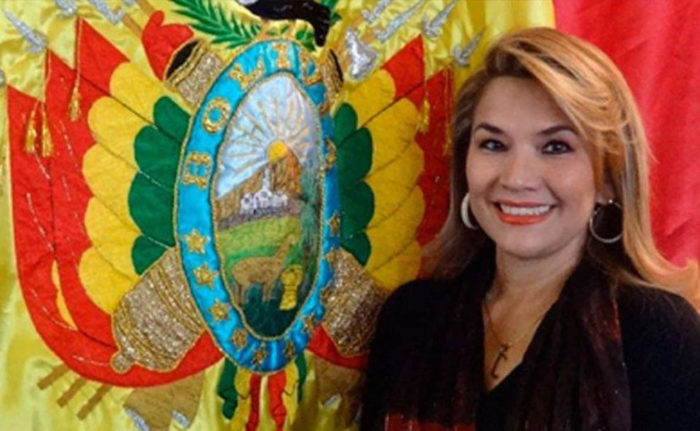 Nevertheless, minutes after Añez declared herself interim president, Bolivia’s highest constitutional court issued a ruling that backed her assumption of power. Añez’ democratic credibility will depend on the speed in which new elections are organised, given that under article Article 169.I of the constitution an interim president has 3 months to call elections.
Nevertheless, minutes after Añez declared herself interim president, Bolivia’s highest constitutional court issued a ruling that backed her assumption of power. Añez’ democratic credibility will depend on the speed in which new elections are organised, given that under article Article 169.I of the constitution an interim president has 3 months to call elections.
Thus Añez’s interim government has one mission, which is to set in train the next presidential election. However a month has already passed and there is little sign of progress. On 2 December the parliament, where MAS commands a majority, asked for applications to join the electoral tribunal, which will have the task if organizing the elections. More than 500 people applied, which means sifting through the pile of applications. It is estimated that by 18 December the members of the electoral tribunal will be named.
Next steps for Morales and MAS
During Morales’ brief asylum in Mexico, he stated that he would not be a candidate in the next presidential election, in order to avoid further violence. However, more than a personal choice, this seemed to be a choice made by his party. For the first time since its creation , there is division in MAS, split between Morales loyalists and supporters of dialogue. This week Eva Copa, president of the Chamber of Senators and from the moderate wing of MAS, accused Adriana Salvaterra, former president of the Chamber of Senators, of being a Morales hardliner and subjecting her to harassment.
On Saturday 23 November, congress approved and passed legislation annulling both the presidential and congressional elections of 20 October, and called for new elections with Evo Morales and Alvaro Garcia Linera banned from participating. Morales’ party MAS remains for the time being as the majority party, holding two thirds of seats in congress.
Although Morales is now banned from standing, people are sceptical about his actions. Many believe that during his asylum in Mexico, he continued to incite his supporters to violence, in order to return as the only possible pacifier of the country.
Minister of Government Arturo Murillo has made public a video in which you can allegedly hear the former president giving orders to one of the leaders of the protests affiliated to the MAS, to persist in causing conflict in the country by blocking food supplies to the cities. Morales has yet to comment on this video.
In recent days Morales moved to Argentina where he has been granted refugee status. He plans to reside in Salta, next to the border with Bolivia, along with his former vice president and other former ministers, where he will set up his headquarters for the 2020 elections and will allegedly be working as de facto campaign manager of the MAS party.
Now the onus is on the opposition to form a united front to go into the new election. Much will depend on what decisions MAS itself takes: it remains the majority party, independently of any fraud in the original elections. If MAS remains united, participates fully in the elections, is able to sustain its morale and define its position post-Morales, it should remain a significant player, even if it loses its majority. However, if its divisions widen, and if MAS members and candidates are persecuted or threatened by the interim administration, the result of the new elections may be as unsatisfactory for Bolivia’s future as were those of 20 October.
Francesca Hartmann is a dual citizen of both Argentina and Bolivia. She read Philosophy and Politics at Exeter University, and has a Master’s Degree in Law from the University of Law. She lived in Buenos Aires for a year, working for the charity Ingenieros Sin Fronteras.
This article was first published by The Latin America Bureau. For more great articles visit www.lab.org.uk


